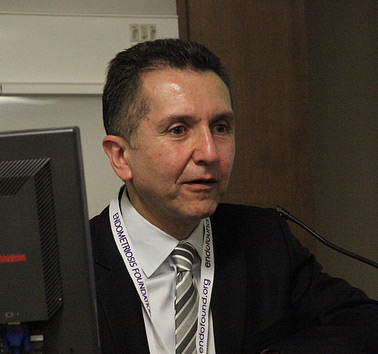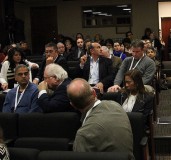Endometriosis Foundation of America
Endometriosis 2013 / Practical Management of Endometriosis
Serdar Bulun, MD
Hi, I would like to thank Dr. Seckin and all of you for being here. It is really humbling to talk among the endometriosis giants. Some of the things that I will talk about are maybe controversial. It is just that I will tell you how I handle patients in my own practice. In some of these areas there is not enough data to come up with long term conclusions and for some of them there are controversial data.
Most of the time when I see a patient I usually ask this patient about her teenage years. It is interesting that almost 95 percent, or more, of the endometriosis patients that I see - all of these women have a history of severe dysmenorrhea, often starting at menarche. Most of the time they go to the ER and they miss school days and stuff like that, usually I see the patients right around here. By their 20s chronic pelvic pain becomes prevalent. In the late 20s, early 30s the first laparoscopy and diagnosis is usually performed and by this time the patient has her own insurance and becomes more independent of her parents. By their 30s and 40s multiple, and usually ineffective, follow up laparoscopies and experimental medications are performed. You have to understand that part of the reason is we have very few experienced surgeons like those in this room. Most of these patients will be handled by a number of OBGYNs who do maybe one or two endometriosis laparoscopies a year and that may be part of the reason.
Usually they have treated it with oral contraceptives and depot progestin. Lupron would be introduced by then. Again, between 20s and 30s there would be repeated treatments with GnRH agonists and usually these patients end up either LAVH or BSO by this time.
A couple of principles; I believe that the most common form of endometriosis that comes about is through retrograde menstruation. Usually these abnormal cells that exist in maybe 10 percent of all women end up in the pelvic cavity and they populate these areas; albeit small in numbers they have some stem cell characteristics. If they remain on certain areas of the peritoneum we call this peritoneal endometriosis and there might be a population of corpus luteum or hemorrhagic cysts that later turn into endometriomas, probably this is the most common mechanism. Then, if there are repeated episodes of cells that are falling into the rectovaginal pouch, when a surgeon looks at it, it looks really invasive and that would probably be the most common mechanism of a rectovaginal nodule.
Probably the most prevalent and obvious mechanism that contributes to endometriosis is ovulation. We still do not understand how ovulation contributes to endometriosis but as a result the ovary makes estradiol and progesterone and they are the hormones that affect either endometrium or endometriosis. Usually at the time of pain their effects are more striking. In these endometriosis implants they respond to estradiol and progesterone through persistence, growth and inflammation. This is important because, as you know, when we disrupt ovulation through GnRH agonists, continuous oral contraceptives or high dose progestins, this is a somewhat effective treatment in some of these patients.
This is how I usually handle the patients in my practice. If there is undiagnosed suspected endometriosis for patients presenting with dysmenorrhea, dyspareunia or chronic pelvic pain, I usually perform a pelvic exam and vaginal ultrasound. If there is an endometrioma or rectovaginal nodule, either by history or exam, I refer these patients for laparoscopy resection by an experienced surgeon. Usually this is one of the surgeons who does at least four or five of these cases a week and these are resected because this group is not going to respond to medical treatment, we know that.
If I do not find any endometrioma or rectovaginal nodule I usually offer these two treatments to the patient challenged by continuous oral contraceptive or diagnostic laparoscopy, again, resection. This is the key word, by an "experienced" surgeon, very important. Either after surgery or if the patient has not responded to oral contraceptives in a satisfactory manner, I put them on either long term oral contraceptive, or in this case, I think this arrow should come here, I would add an aromatase inhibitor to see if this would help. If that does not help then the patient may be referred for repeat surgery, Lupron depot or Danazol. But the important thing is the first surgery should have been performed by an experienced surgeon so there would not be any question that everything that could be done was performed.
On the other hand I think these are the real difficult patients if the patient had a history of endometriosis through a previous laparoscopy. It is a fairly similar algorithm. I think endometrioma and rectovaginal nodules should be handled by surgery. Long term oral contraceptive use is my first line treatment and then I would have aromatase inhibitor, and rarely, I go to either Lupron or Danazol. A repeat surgery may be another viable option.
What are the response rates for pain relief? It is really important to distinguish the two types of patients; the treatment naïve patient who has not seen any endometriosis physician, or patients who have chronic endometriosis and who had previous bouts of therapy. In the absence of a rectovaginal nodule, endometrioma response rates to laparoscopic surgery or medical treatment in treatment naïve patients are very similar. Most of them respond to these treatments, almost 90 to 100 percent. Pain recurs in about 90 percent of these patients within two to five years after discontinuation. I think this is rather like my opinion as combined with the literature.
On the other hand, response rates to surgery or medication decreases in the previously treated patient population. The average response rate is probably much lower, around half in this case, and pain recurs much earlier, within six months to two years after discontinuation in this group.
I will talk to you about cases of refractory endometriosis because I think this is the really challenging group and we define it as endometriosis previously diagnosed by laparoscopy and pain not responding to recent medical or surgical treatment attempts. Usually the options for these patients include medical treatment, laparoscopic resection, ablation or LAVH plus BSO.
Laparoscopy resection is important. It allows assessment of the extent of the disease and should be performed by an experienced surgeon - very important. Resection is superior to vaporization or fulguration. We know this through...study. En bloc stripping of cul-de-sac peritoneum in the absence of any obvious disease sometimes helps as a last resort. Rectovaginal dissection should be considered especially for dyspareunia in these cases even if the rectovaginal nodule has not been demonstrated.
Oral contraceptives are probably still under utilized and we will come to that. These are some of the medical treatment options. These are the progestins. I rarely use progestins because if a patient has not responded to oral contraceptives in a continuous manner I have found they rarely respond to progestins. GnRH analogues have been used more broadly in the past. However, I think the current alternatives, such as oral contraceptive plus an aromatase inhibitor, are probably similar - they give similar results to GnRH analogues with respect to medical treatment.
Danazol, this is almost like a tie breaker. The moment I mention to a patient the androgenic side effects the patient runs out of my office. For those of you who can give Danazol I congratulate you. I cannot. I mean it is very difficult to miss a patient where the cause/benefit ratio is better.
Ineffective treatments: endometrial ablation, it does not work; hysterectomy without oophorectomy, again, it does not work; LUNA does not work. In my opinion progestin IUDs have no advantage over continuous oral contraceptives, they probably produce inferior results. Presacral neurectomy just by itself does not work. If some of these things could be like LUNA, or presacral neurectomy would be performed through effective resection of endometriosis, that is a different story.
Experimental treatments include aromatase inhibitors either Letrozole or Anastrozole in the doses that I use for breast cancer. Aromatase inhibitor only in postmenopausal women is a treatment of choice for these women. I usually combine aromatase inhibitors with oral contraceptives or progestins in premenopausal women to suppress...activity will come to that. RU486 at 5 mg doses per day, much, much lower than the...doses have been reported to be effective. We recently had some of the other selective progesterone receptor modulators or antiprogestins such as Ulipristal Acetate.
What are the...to use and aromatase inhibitors in a postmenopausal woman? It is very straightforward. The use of aromatase inhibitors suppresses aromatase in the peripheral tissues and also in endometriosis. That is how it works. Because these women are already menopausal its effects on the brain are not consequential.
In premenopausal women if you use only an aromatase inhibitor, at least theoretically, you might be able to induce...follicle agenesis. A certain number of these women develop ovarian cysts that rupture and, you know, causes some unwanted side effects. That is why most of the time I stay on the safe side and add a continuous oral contraceptive or progestin to an aromatase inhibitor.
This was one of the original studies that we performed. We combined the aromatase inhibitor Letrozole with Norethindrone Acetate. These patients were all refractory to existing treatments and the pain scores went down in the majority of the patients. It was significant.
This was the only study that we looked at before and after the extent of endometriosis. This is endometriosis, mostly peritoneal. We did not treat any cases of rectovaginal endometriosis or ovarian endometriomas for the obvious reasons. We took tiny biopsies but we did not resect the entire endometriotic lesions in these patients. This is the same patient, same location after treatment. The obvious criticism was that these patients were also treated with Norethindrone Acetate that suppressed ovulation in addition to Letrozole but they did not respond to Norethindrone Acetate or oral contraceptive use before we introduced this treatment.
These are the pain scores of another group of patients who were treated with Anastrozole plus an oral contraceptive. This is another approach. These are all refractory patients who have not responded to any other surgical or medical treatments in the hands of the referring surgeons. The pain scores decreased in the majority of the patients in a gradual manner. In very few of these patients we achieved full pain relief but they all said that the results were satisfying to them. After we stopped the treatment in the majority of the patients the pain recurred.
This is another randomized trial which was performed by a Turkish group. I do not have a direct link to this study. But what they did was compare in treatment naïve patients the use of a GnRH agonist only versus GnRH agonist plus an aromatase inhibitor. In 24 months the pain recurrence rates were much lower in the GnRH agonist plus Anastrozole group who received this treatment for six months versus the GnRH agonist only. These are the pain scores and you can see that the combination group did much better with respect to pain scores. But with respect to bone loss it is 24 weeks. For example the addition of an aromatase inhibitor caused more bone loss and then these patients recovered some of this bone loss but there was less bone loss in the GnRH agonist only group.
Antiprogestins are interesting and as gynecologists I think we are the only group who use progestins more prevalently than any other physician. We are all familiar with these medications, like MPA is Provera, Norethindrone Acetate is a progestin and they are progestins and they show some beneficial effects, in my mind, primarily through suppressing the pituitary and ovulation. Progesterone antagonists on the other hand, pure antagonist could not be used because of their toxic side effects so the pharmaceutical companies came up with some of these medications. You are all familiar with RU486 and this medication is Ulipristal. It was just introduced in Europe to treat fibroids. I think it has - all of these medications - have a great potential to be used in the treatment of endometriosis. Amenorrhea in the majority of these patients is a key either through anovulation or direct endometrial effects. The pain relief is possibly better than progestin only treatments. The only concerning side effect is that they cause this cystic glandular dilatation often associated with both admixed estrogen and progestin epithelial effects. It is sort of a bizarre endometrial histology. The endometrial thickness is usually related to these glandular dilatations so you cannot follow up these patients through, like, vaginal ultrasounds or through endometrial thickness measurements.
I just put everything together and these are some of the speculations that I have regarding the disease endometriosis.
I forgot to emphasize one point. When I put a patient on continuous oral contraceptives it is very important to educate these patients and set their expectations. Most of the time I tell them that their pain is going to decrease gradually; I usually give them a pain score. If they look at the pain score and they go through oral contraceptives at the end of say, six months, they come back to see me - if they compare the original pain scores to their current pain scores I think that helps. I also set their expectations for breakthrough bleeding. Most of these patients, almost 60 percent, will achieve either minimal breakthrough bleeding or amenorrhea by the end of six months. I usually use an oral contraceptive regimen that has 35 micrograms of ethinyl estradiol plus 1 mg of Norethindrone. That works the best in my hands. That increases the compliance of these patients for an oral contraceptive regimen.
I think that the symptomatology of endometriosis represents a spectrum of a broad chronic disease involving a basic pathology in pelvic tissues including the endometrium. The disease becomes initially manifest with the so-called primary dysmenorrhea in teenage years and advances to laparoscopically visible endometriosis later. This is probably the majority of the cases, maybe 95 percent that occur through Sampson's mechanism.
Sampson's - I found this explains the majority of the cases of peritoneal endometriosis, rectovaginal nodule and ovarian endometrioma. In epigenetically susceptible women, the risk of development of endometriosis or its symptoms increases in direct proportion with the number of ovulatory menses a woman experiences. Long term suppression of menses with oral contraceptives in young women with primary dysmenorrhea should decrease the risk of symptomatic endometriosis in the upcoming years. It would be clinically beneficial to view pelvic symptoms associated with endometriosis as a spectrum and broaden its definition to a "systemic disease characterized with pelvic pain responsive to hormonal suppression or surgical resection of endometriotic tissue".
I think this would be more helpful in a global sense to handle these patients because to tell this patient that either she has, or does not have endometriosis although she continues to experience pain which is hormone responsive does not help with the patient. It may help with some sub-sets of patients but when you look at the entire group and see this from a public health perspective it is an interesting different view.
I am going to stop here and thank you so much for providing me with this opportunity.










